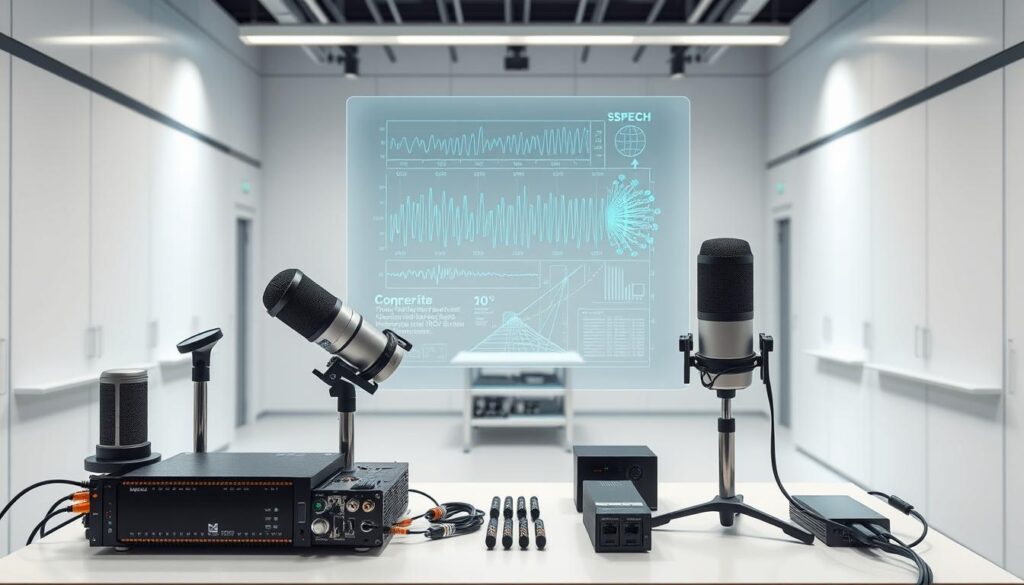Modern applications demand intuitive ways to interact with technology. From smartphones to smart homes, systems that understand spoken commands have become essential. This evolution began with simple digit-identification tools and now powers complex AI-driven platforms.
Java remains a versatile platform for building these advanced features. Its cross-platform compatibility and robust libraries make it ideal for integrating audio-driven functionality. Developers can leverage tools like CMU Sphinx or VOSK to transform spoken input into actionable data.
Open-source frameworks simplify tasks like converting speech to text or processing audio files. These solutions support multiple formats while maintaining accuracy across diverse environments. The result? Applications that respond naturally to user needs without complicated setups.
This guide walks through practical implementation steps. You’ll learn how to add real-time input handling, optimize performance, and avoid common pitfalls. Let’s explore how to create applications that listen as effectively as they perform.
Key Takeaways
- Speech technology has evolved from basic systems to AI-powered solutions
- Java’s flexibility supports seamless integration of audio-driven features
- Open-source libraries reduce development time for voice-enabled apps
- Cross-platform compatibility ensures wider accessibility
- Practical examples simplify complex implementation processes
Understanding the Fundamentals of Voice Recognition
Human-machine interaction transformed when systems learned to interpret spoken words. Early attempts focused on recognizing single digits in the 1950s, while today’s tools handle entire sentences across 100+ languages.
From Beeps to Brain-Like Processing
The journey began with clunky devices that only understood numbers. By the 1990s, basic commands like “call home” became possible. Modern systems use neural networks that mimic how brains process patterns. This shift enabled:
- Real-time translation between languages
- Context-aware responses (like knowing “it’s cold here” means adjust thermostat)
- Accurate interpretation of regional accents
Breaking Down the Magic
Here’s how your words become actionable data:
- Audio capture: Microphones convert sound waves into digital files
- Noise filtering: Background sounds get removed
- Pattern matching: Systems compare your speech to trained models
Advanced acoustic modeling helps distinguish similar words like “write” and “right.” Language models predict likely phrases, while machine learning improves accuracy with every interaction. These layers work together like orchestra sections – each enhancing the others’ performance.
Setting Up Your Java Environment for Speech Recognition
Creating efficient audio-driven applications starts with proper tools. A well-configured workspace ensures smooth integration of features that process spoken commands. Let’s prepare your system for building responsive solutions.

Installing Core Components
Begin by downloading the latest Java Development Kit (JDK). Set environment variables like JAVA_HOME to point to your installation directory. This allows command-line tools and IDEs to locate critical resources.
Choose an Integrated Development Environment (IDE) that fits your workflow:
| Feature | Eclipse | IntelliJ IDEA |
|---|---|---|
| Plugin Ecosystem | Extensive | Curated |
| Ease of Use | Beginner-friendly | Steeper learning curve |
| Updates | Community-driven | Frequent official releases |
| Cost | Free | Paid/Free editions |
Adding Specialized Libraries
Enhance your project with libraries like CMU Sphinx. Add dependencies using build tools like Maven:
<dependency>
<groupId>edu.cmu.sphinx</groupId>
<artifactId>sphinx4-core</artifactId>
<version>1.0.0</version>
</dependency>
Test your setup with sample code that converts audio files to text. Ensure your microphone permissions are enabled for real-time input handling. If errors occur, verify library versions match your JDK installation.
With these steps complete, you’re ready to transform sound waves into actionable data. Next, we’ll implement actual recognition features using your optimized environment.
Integrating voice recognition java into Your Applications
Conversational interfaces now feel less like sci-fi and more like standard user expectations. Developers can implement audio-driven features using proven libraries like CMU Sphinx and VOSK. These tools transform microphone input into executable actions through streamlined workflows.
Step-by-Step Implementation with Leading Libraries
Start with CMU Sphinx for basic functionality. Configure your project using Maven:
Configuration config = new Configuration();
config.setAcousticModelPath("resource:/edu/cmu/sphinx/models/en-us");
StreamSpeechRecognizer recognizer = new StreamSpeechRecognizer(config);
recognizer.startRecognition(new FileInputStream("audio.wav"));
VOSK offers enhanced accuracy for complex scenarios. Initialize the engine with:
Model model = new Model("vosk-model-en-us-0.22");
Recognizer recognizer = new Recognizer(model, 16000.0f);
byte[] buffer = new byte[4096];
while (inputStream.read(buffer) >= 0) {
String result = recognizer.acceptWaveForm(buffer, buffer.length);
}
Solving Real-World Development Hurdles
Three frequent challenges and solutions:
- Garbled output: Ensure audio uses 16kHz sample rate and 16-bit PCM format
- Laggy responses: Adjust buffer sizes and preload language models
- Silence detection failures: Implement energy threshold calibration
Transitioning from file processing to live input? Use javax.sound.sampled for microphone access. Test with headphones to eliminate feedback loops. Remember: Clear documentation beats trial-and-error debugging.
Enhancing Accuracy and Performance in Voice-Enabled Applications
Clear communication between users and technology starts with crisp audio. Even advanced systems struggle when background noise or poor equipment muddies the input. Refining these elements ensures your application understands commands as intended.

Optimizing Audio Input and Signal Processing
Start with hardware selection. High-quality microphones capture cleaner sound, reducing errors in conversion. Consider these factors when choosing devices:
| Microphone Type | Best For | Noise Handling |
|---|---|---|
| Dynamic | Loud environments | High |
| Condenser | Studio settings | Moderate |
| USB | General use | Low |
Adjust sample rates to match your needs. A 16kHz rate balances clarity and file size for most speech tasks. Pair this with noise gates that mute inputs below set volume thresholds.
Best Practices for Noise Reduction and Testing
Combine physical and digital solutions. Acoustic panels dampen echoes, while software filters tackle persistent hums. Test these strategies across environments:
- Use spectral subtraction to remove fan noises
- Apply beamforming in multi-mic setups
- Calibrate input sensitivity per user
Continuous testing uncovers hidden issues. One team improved accuracy by 40% after simulating café chatter during trials. Regular updates keep systems adaptable as real-world conditions evolve.
Conclusion
Building applications that understand spoken commands reshapes how we interact with technology. This guide walked through creating systems that process speech recognition effectively – from historical breakthroughs to modern neural networks. Proper environment setup, quality libraries, and precise tuning form the foundation of reliable solutions.
Open-source tools like CMU Sphinx simplify converting audio to text, while newer frameworks boost accuracy. Testing across devices and environments remains crucial. Developers who refine their implementations see fewer errors and faster response times.
The potential grows as these technologies evolve. Start small: experiment with sample projects using the steps outlined. Share your creations, gather feedback, and iterate. Every improvement makes digital interactions feel more natural and intuitive.
Ready to transform user experiences? Your journey toward crafting responsive, speech-aware applications begins now. What innovative features will you build first?
